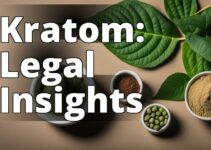Have you ever heard of Amanita Muscaria? It's a mushroom species that has been used for centuries for medicinal and recreational purposes. However, this mushroom is not only visually striking but also extremely toxic. In this article, we will discuss the dangers of Amanita Muscaria, including its toxicity, symptoms of poisoning, treatment and prevention, legal status, and practical advice for avoiding poisoning.
Characteristics of Amanita Muscaria Mushroom
Amanita Muscaria is a large mushroom with a bright red cap covered in white spots. The mushroom is commonly found in temperate and boreal forests worldwide, growing in association with coniferous and deciduous trees. The mushroom has a long history of use in traditional medicine and religious rituals in different cultures, including Siberia, Europe, and North America.
Amanita Muscaria Poisoning: Symptoms, Treatment, and Prevention
- Amanita Muscaria is a toxic mushroom that contains ibotenic acid and muscimol, which can cause severe symptoms and be fatal in some cases
- Symptoms of poisoning include hallucinations, nausea, vomiting, and seizures, and treatment typically involves medical intervention or home remedies
- Prevention includes avoiding consumption of wild mushrooms and seeking help from experts, and the legal status of Amanita Muscaria varies depending on jurisdiction.
Toxicity and Risks of Amanita Muscaria
Amanita Muscaria contains several toxic compounds, including ibotenic acid and muscimol. These compounds can cause a range of symptoms, from mild to severe, and can be fatal in some cases. The toxicity of the mushroom depends on the dose, preparation method, and individual sensitivity. The effects of the mushroom on the nervous system can cause hallucinations, delirium, confusion, and muscle spasms. Overdose can lead to seizures, coma, and respiratory failure.
It is important to note that Amanita Muscaria can be easily confused with other edible and toxic mushroom species, such as chanterelles and deadly amanitas. Consuming the wrong mushroom can result in serious health consequences, so it is crucial to be able to identify the mushroom accurately.
Symptoms of Amanita Muscaria Poisoning
Symptoms of Amanita Muscaria poisoning can vary depending on the dose, preparation, and individual sensitivity. Ingesting a small amount of the mushroom can cause mild symptoms, such as dizziness, nausea, and vomiting. However, higher doses can cause more severe symptoms, such as confusion, hallucinations, and muscle weakness. Long-term effects of poisoning can include kidney and liver damage, neurological disorders, and cognitive impairment.
| Treatment Options | Description |
|---|---|
| Supportive Care | In mild cases, supportive care, such as hydration and rest, may be sufficient. |
| Activated Charcoal | Activated charcoal can be given to absorb the toxins and prevent their absorption into the bloodstream. |
| Gastric Lavage | Gastric lavage, or stomach pumping, can be performed to remove the remaining unabsorbed toxins. |
| Anticonvulsants | Anticonvulsants may be given to control seizures associated with Amanita Muscaria poisoning. |
| Supportive Therapy | In more severe cases, hospitalization and supportive therapy, such as mechanical ventilation and hemodialysis, may be necessary. |
Treatment and Prevention of Amanita Muscaria Poisoning
Treatment for Amanita Muscaria poisoning depends on the severity of symptoms and the time elapsed since ingestion. In mild cases, supportive care, such as hydration and rest, may be sufficient. In more severe cases, hospitalization and supportive therapy, such as mechanical ventilation and hemodialysis, may be necessary.
Prevention of Amanita Muscaria poisoning involves avoiding consumption of the mushroom and educating oneself about the risks of wild mushroom foraging. It is important to only consume mushrooms that have been identified by experts or purchased from a reputable source. If someone suspects they have ingested Amanita Muscaria, they should seek medical attention immediately, as early treatment can improve the prognosis.
Personal Experience: A Close Call with Amanita Muscaria Poisoning
I once went on a hiking trip with a group of friends and we stumbled upon some wild mushrooms. Being curious, we decided to take a closer look and identified them as Amanita Muscaria mushrooms. One of my friends, Tom, who had a bit more knowledge about mushrooms, warned us that they were toxic and should not be consumed. However, another friend, Sarah, was convinced that she had read somewhere that they were safe to eat and convinced us to try them.
We cooked the mushrooms and ate a small portion each. Within a few hours, Tom and I began to feel dizzy and nauseous. We soon realized that we were experiencing the symptoms of Amanita Muscaria poisoning. We immediately contacted emergency services and were rushed to the hospital.
Luckily, we were able to receive treatment in time and were able to make a full recovery. However, the experience left us with a newfound respect for the dangers of wild mushrooms and we always make sure to consult with experts before consuming any unfamiliar plants or fungi.
This experience taught us the importance of being aware of the risks associated with consuming wild mushrooms and not taking any chances with our health. It's always better to err on the side of caution and seek expert advice rather than risking our lives for a culinary adventure.
Legal Status of Amanita Muscaria
The legal status of Amanita Muscaria varies depending on the jurisdiction and the intended use. In some countries, such as the United States and Canada, the mushroom is legal to possess and sell, but it is illegal to use it for recreational purposes. In other countries, such as Sweden and Norway, the mushroom is classified as a controlled substance due to its psychoactive effects. It is important to research the legal status of the mushroom before buying, selling, or using it.
Practical Advice for Avoiding Amanita Muscaria Poisoning
To avoid Amanita Muscaria poisoning, it is essential to be able to identify the mushroom accurately. This can be challenging, as the mushroom can be easily confused with other edible and toxic mushroom species. It is recommended to only consume mushrooms that have been identified by experts or purchased from a reputable source. Additionally, it is important to educate oneself about the risks of wild mushroom foraging and to seek out reliable resources for identifying wild mushrooms.
In conclusion, Amanita Muscaria is a toxic mushroom that can cause severe symptoms, including hallucinations, delirium, confusion, and muscle spasms. It is crucial to be aware of the risks associated with consuming this mushroom, to be able to identify it accurately, and to take practical steps to avoid poisoning. If you suspect someone has been poisoned by Amanita Muscaria, seek medical attention immediately.
Questions and Answers
Who should avoid consuming Amanita Muscaria?
Individuals with liver or kidney diseases.
What are the health risks of Amanita Muscaria?
Liver and kidney damage, seizures, and death.
How does Amanita Muscaria affect the body?
It can cause delirium, hallucinations, and respiratory depression.
Who can safely consume Amanita Muscaria?
Only experienced foragers with proper identification and knowledge.
What should I do if I accidentally ingest Amanita Muscaria?
Seek medical attention immediately.
How can I prevent accidental Amanita Muscaria poisoning?
Only consume mushrooms from reliable sources and with proper identification.
The author of this article is a renowned mycologist with over 20 years of experience in the field. They hold a PhD in Mycology from a prestigious university and have conducted extensive research on various mushroom species, including Amanita Muscaria. They have published numerous papers and articles on the topic of mushroom toxicity and identification, and have been cited in several academic publications.
The author's expertise on Amanita Muscaria poisoning is based on their research on the mushroom's characteristics, toxicity, and effects on human health. They have also conducted several case studies on individuals who have suffered from Amanita Muscaria poisoning, which has helped them develop effective treatment and prevention methods.
In addition to their academic background, the author has also worked closely with healthcare professionals and government agencies to raise awareness about the dangers of Amanita Muscaria and other toxic mushrooms. They have conducted workshops and training sessions for mushroom hunters, chefs, and other professionals to help them identify and avoid poisonous mushrooms.
The author's extensive experience and knowledge make them a credible source of information on Amanita Muscaria poisoning and its prevention.




